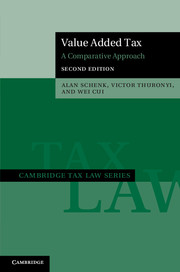Book contents
- Frontmatter
- Dedication
- Contents
- List of Tables and Charts
- List of Cases
- Preface to the Second Edition
- 1 Introduction
- 2 Consumption Tax Forms and Base Alterations
- 3 Varieties of VAT in Use
- 4 Registration, Taxpayer, and Taxable Activity
- 5 Taxable Supplies and Tax Invoices
- 6 The Tax Credit Mechanism
- 7 Introduction to Cross-Border Aspects of VAT
- 8 Timing and Valuation Rules
- 9 Zero-Rating, Exemptions, and Exempt Entities
- 10 VAT Evasion and Avoidance
- 11 Gambling and Financial Services (Other than Insurance)
- 12 Insurance
- 13 Real Property
- 14 An Anatomy of the Chinese VAT
- 15 Interjurisdictional Aspects
- Appendix VATs Worldwide
- Index
- References
8 - Timing and Valuation Rules
Published online by Cambridge University Press: 05 February 2015
- Frontmatter
- Dedication
- Contents
- List of Tables and Charts
- List of Cases
- Preface to the Second Edition
- 1 Introduction
- 2 Consumption Tax Forms and Base Alterations
- 3 Varieties of VAT in Use
- 4 Registration, Taxpayer, and Taxable Activity
- 5 Taxable Supplies and Tax Invoices
- 6 The Tax Credit Mechanism
- 7 Introduction to Cross-Border Aspects of VAT
- 8 Timing and Valuation Rules
- 9 Zero-Rating, Exemptions, and Exempt Entities
- 10 VAT Evasion and Avoidance
- 11 Gambling and Financial Services (Other than Insurance)
- 12 Insurance
- 13 Real Property
- 14 An Anatomy of the Chinese VAT
- 15 Interjurisdictional Aspects
- Appendix VATs Worldwide
- Index
- References
Summary
Timing (or tax accounting) rules are used to identify the tax period in which a taxpayer must pay tax on imports, report taxable sales, and claim deductions or credits for tax paid on allowable imports and domestic purchases. When a VAT is introduced or the rate is changed, effective date and transition rules are needed to identify which sales and purchases are subject to the old rules and which to the new or amended law.
VAT generally is imposed on the sum of the amount of money and the value of non-monetary consideration received for a taxable supply. Special valuation rules are provided for particular transactions. This chapter covers the timing, transition, and valuation rules.
The Timing Rules
Accrual, Hybrid, and Cash Methods – in General
This section discusses the rules governing the basic methods of accounting for VAT. It does not discuss the innumerable varieties of special schemes for retailers that are available in many countries.
Most taxpayers must use the accrual or a hybrid method of accounting to report sales and claim input credits under a credit-invoice VAT (like the European VATs). Under the accrual method, taxpayers generally report taxable sales when goods are sold or when services are rendered, subject to rules accelerating the reporting, and they claim input credits when the business acquires the goods or services eligible for the input credits.
- Type
- Chapter
- Information
- Value Added TaxA Comparative Approach, pp. 226 - 259Publisher: Cambridge University PressPrint publication year: 2015



